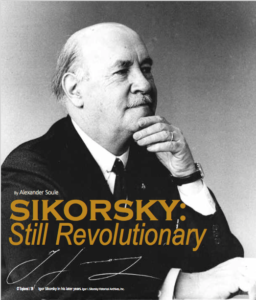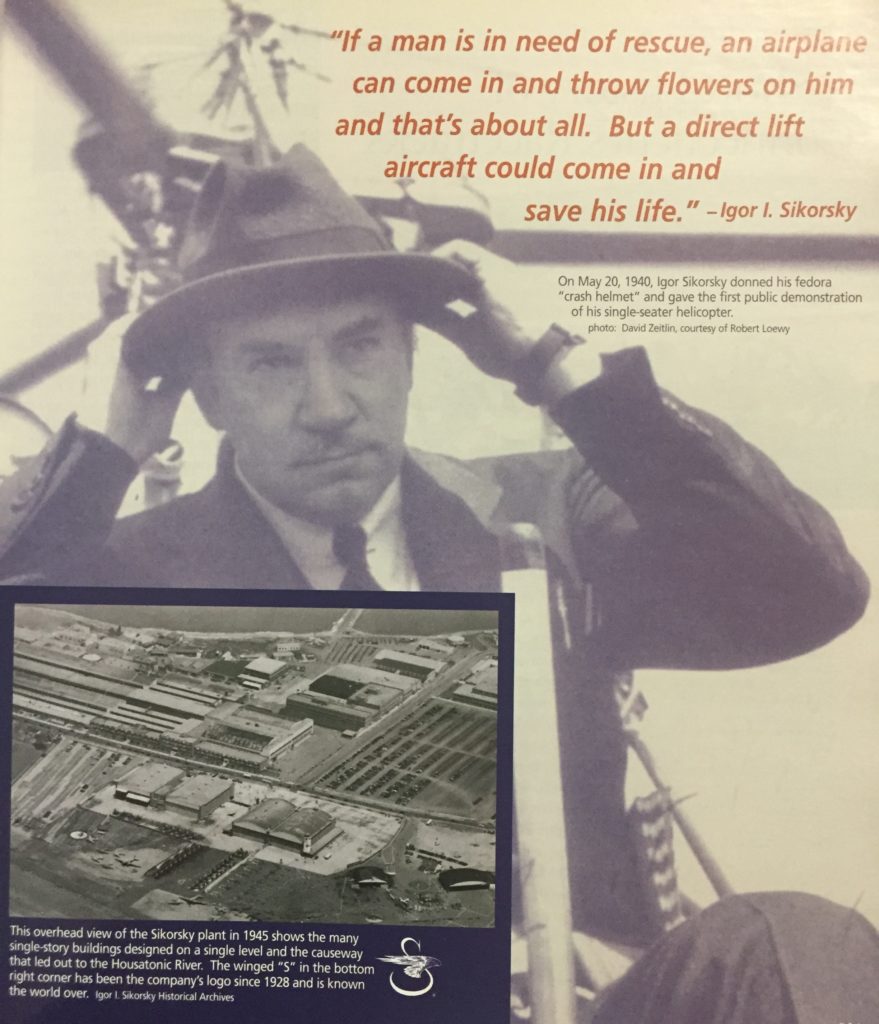By Mary M. Donohue
(c) Connecticut Explored Inc. SPRING 2008
Subscribe/Buy the Issue!
If a man is in need of rescue, an airplane can come in and throw flowers on him and that’s about all. But a direct lift aircraft could come in and save his life.” – Igor I. Sikorsky
Innovations in design and production plus smart business practices made Connecticut’s firearms, helicopters, and nuclear submarines first in the world. Each of these products has been celebrated by historians, but what about the places where they were manufactured? The Vought-Sikorsky Aircraft plant in Stratford, once a hub of aeronautical innovation, today stands vacant, waiting for a future. Sergei Sikorsky and Mary Donohue provide the back-story.
With an illustrious career in Russia behind him, Igor Sikorsky (1889-1972) immigrated to the United States in 1919 and formed an aviation company on Long Island in 1923. By 1928, the company purchased land in Stratford, Connecticut to build a completely modern plant.
My father had rented a small factory on Long Island but in 1928, the S-38 aircraft became immediately successful with orders pouring in,” remembers Sergei Sikorsky. “Company president Arnold Dickenson, a New Englander, felt that my dad ought to find a new place in southern New England specially for aviation. In 1928, Dad visited [Massachusetts, Rhode Island, and Connecticut] looking for suitable property. Stratford was perfect, with the Housatonic River right there and the Long Island Sound close and the new Bridgeport Airport across the river. Dad needed to test seaplanes, amphibian planes, as well as land planes. The whole area was an open green farm field. He purchased it in 1928, built the factory over the winter and spring. A S-38 plane was the first one built in Stratford. He delivered it November 29, 1929.”
The number of historically significant breakthroughs that occurred at the plant goes on for pages. Some key events include the development and production of innovative amphibious aircraft and flying boats; the first modern helicopter, the VS-300 demonstrated in free flight in 1940; development from 1941 to 1943 of the R-4, the world’s first production helicopter; manufacture of thousands of WWII “Corsair” aircraft; and the development and production from 1951 to1997 of pioneering gas turbine engines for helicopters, airplanes, ships, hovercraft, and tanks.
Two milestone events stand out in my memory,” noted Sikorsky. “When I was seven or eight we watched the S-40 take off on land and water. The president of Pan American Airlines and Charles Lindbergh were standing there with us. [And] when I was 15 years old, we went to the factory for the first public demonstration of the Sikorsky helicopter. It was a single-seater. That was on May 20, 1940.”
A Plant for the Future
Clearly visible today from the Merritt Parkway bridge over the Housatonic River, the Vought-Sikorsky Aircraft Plant covers a 65-acre site that includes 27 buildings and a 50-foot-wide causeway that extends 1,500 feet into the river. In a recent nomination that resulted in the plant’s being listed on the State Register of Historic Places, Connecticut historian Dr. Bruce Clouette described the significance of the complex:
The Sikorsky plant is a premier example of the role played by research, engineering, and inventive insight in sustaining the aerospace sector. The all-important role of technological expertise is even embodied in the plant’s physical form: engineering offices, laboratories, and test facilities made up a substantial portion of the plant in its earliest form and were expanded proportionately with the enlargement of the manufacturing space.”
The factory buildings illustrate a distinctive architectural form developed in the first half of the 20th century for large-scale manufacturing, particularly in Detroit for the auto industry. The buildings were sleek and single-level, placed on a concrete slab. Steel-frame construction allowed glass and brick curtain walls surmounted by roof monitors (a type of skylight) that allowed for maximum light and ventilation. Both Vought-Sikorsky’s 1929-1930 buildings, designed by the Bridgeport firm of Fletcher-Thompson, and the 1940s structures designed by the firm of Albert Kahn, a leading industrial architect, demonstrate the shift from factories arranged with multiple floors stacked vertically (the traditional New England textile mill, for example) to those that spread out horizontally, allowing for almost limitless expansion.
Presently, the Vought-Sikorsky Aircraft Plant’s future is uncertain. Currently known as the Stratford Army Engine Plant, it is owned by the U.S. Department of the Army. A local group, led by former State Senator George “Doc” Gunther, hopes to save a portion of the complex for an air museum celebrating Sikorsky’s place in aviation history at the site where his innovations were made.
Explore!
“Sikorsky–Still Revolutionary,” Spring 2014
Read more about Connecticut industrial history and innovation with
The Connecticut Brand Collection
6 issues: $35 (a $49 value!)
This collection features stories on Connecticut’s manufacturing and industrial history. You’ll read about products—some well known, some surprising—that were made or conceived in Connecticut. Delve into the places and people that made these products, and how Connecticut’s manufacturing past impacted the day-to-day lives of Connecticut’s people in places like Bridgeport, New Britain, Waterbury, and more!
For more information visit www.sikorskyarchives.com and www.sikorsky.com. For historic photos, see The Sikorsky Legacy (Images of Aviation) by Sergei I. Sikorsky (Arcadia Publishing, 2007).

